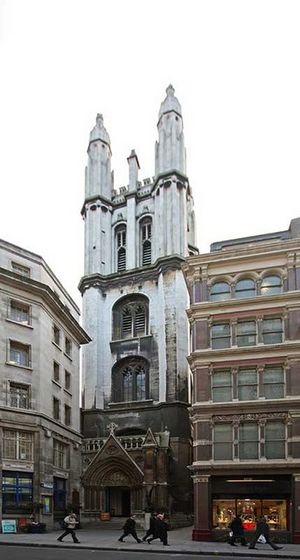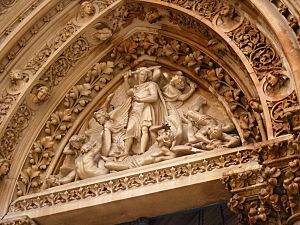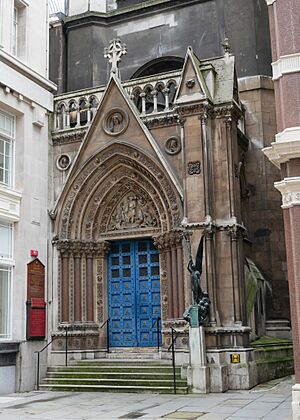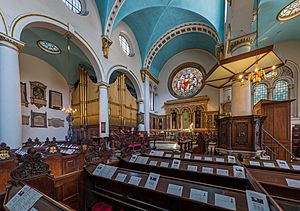St Michael, Cornhill facts for kids
Quick facts for kids St Michael, Cornhill |
|
|---|---|

View of church from Cornhill
|
|
| Location | London, EC3 |
| Country | United Kingdom |
| Denomination | Church of England |
| Churchmanship | Book of Common Prayer |
| Architecture | |
| Heritage designation | Grade I listed building |
| Architect(s) | Sir Christopher Wren, Nicholas Hawksmoor |
| Style | Neo-Gothic |
| Years built | 1670 |
| Administration | |
| Diocese | London |
St Michael, Cornhill is an old church in the City of London. It has been a church since before the Norman Conquest in 1066. The church is in the area called Cornhill. The original medieval church was destroyed in the Great Fire of London in 1666. The church you see today was built after that fire. Many people believe Sir Christopher Wren designed it. The top parts of its tower were designed by Nicholas Hawksmoor. In the 1800s, Sir George Gilbert Scott and Herbert Williams added many beautiful decorations to the church.
Contents
How Old is St Michael's Church?
The church of St Michael, Cornhill, sits right on top of an ancient Roman building. This was a large public building called a basilica, built around 90–120 AD. Even though the church walls are not exactly aligned with the Roman building, some of its foundations rest on the old Roman ones.
The first time this church was mentioned was in 1055. A priest named Alnod gave it to the Abbey of Evesham. The church stayed with the Abbey until 1503. Then, it was given to the Drapers' Company, a group of merchants.
A new tower was built in 1421, possibly after a fire. John Stow, a famous historian, described the church as "fair and beautiful." He also mentioned a churchyard with a "proper cloister" (a covered walkway). There were also places for singers and a special cross where sermons were given.
There's an old folk tale from the early 1500s about the church bells. Some bellringers were ringing the bells during a storm. They saw "an ugly shapen sight" and fainted. When they woke up, they found scratch marks on the stone walls. For many years, people called these the 'Devil's clawmarks'.
Rebuilding After the Great Fire of London
The medieval church, except for its tower, was destroyed in the Great Fire of London in 1666. Building the new church started in 1672. People usually say Sir Christopher Wren designed it. However, some experts think Wren's office might not have designed the main part of the church. They believe the church leaders worked directly with the builders.
The new church was 83 feet long and 67 feet wide. Inside, it had a main area (nave) and side sections (aisles). These were separated by columns. The ceiling was arched. There was an organ at the back and a special screen (reredos) at the front. This screen had paintings of Moses and Aaron. The walls were not perfectly straight, which shows they reused the old medieval foundations.
The old 15th-century tower was not stable. So, in 1704, the archbishop ordered it to be taken down. A new tower, 130 feet tall, was finished in 1721. This new tower was built in a Gothic style, like the famous Magdalen College, Oxford. Building started in 1715, using money from a special coal fund. The lower parts of the tower were likely designed by William Dickinson from Christopher Wren's office. They ran out of money, and work stopped in 1717. The tower was finally completed in 1722 with help from a special commission. The upper parts were designed by Nicholas Hawksmoor. The tower has four fancy turrets at the top, which look like those at King's College Chapel in Cambridge.
The church had repairs in 1751, 1775, and 1790. During the 1790 repairs, some windows were made round. Also, a new pulpit, altar rail, and stained glass were added.
Victorian Changes and Decorations
In the late 1850s, the Drapers' Company decided to pay for a big project to decorate St Michael's. They asked George Gilbert Scott to do the work.
Scott removed a house next to the tower and built a fancy porch instead. This porch, built between 1858 and 1860, faces Cornhill. It has detailed carvings by John Birnie Philip. One carving shows "St Michael disputing with Satan" above the entrance. Scott also added Gothic designs to the round windows. New windows were put in the front part of the church (chancel). A beautiful stone screen (reredos) was built, which included the old paintings of Moses and Aaron. The chancel walls were covered with colorful marble panels. The ceiling was also painted with bright colors.
Stained glass windows by Clayton and Bell were put in. The large round window at the front shows Christ in Glory. Other windows tell stories from the life of Christ.
The wooden benches (pews) in the church are also from this time. They are a rare example of complete Victorian church furniture. Each bench end has a different, detailed carving. These were made by Mr. Rogers, following Gilbert Scott's designs. The church also has special pews for the Drapers' Company, who are the church's patrons.
More decorations were added in the late 1860s by Herbert Williams. He built a covered walkway on the south side of the church. Inside, he added rich painted designs to Wren's columns. The reredos was made even fancier with inlaid marble. The chancel got new white marble steps and a mosaic floor. A surprising change was cutting circular openings in the arched ceilings of the side aisles. These were filled with stained glass, with skylights above them.
Most of the original furniture was replaced during these Victorian changes. However, the baptismal font from 1672, given by James Paul, was kept.
Recent History of the Church
A memorial for the First World War was put up next to the church entrance in 1920. It has a bronze statue of St Michael by Richard Reginald Goulden. This memorial became a protected historical building in 2016.
The church was not badly damaged during the Second World War. It was named a Grade I listed building (a very important historical building) in 1950. In 1960, the colorful Victorian paint was changed to a simpler blue, gold, and white.
A new set of twelve bells was put in the tower in April 2011. They were made by Taylors of Loughborough.
The church has some of the oldest records of churchwardens (people who manage the church) in the City of London. These records are now kept at the Guildhall Library.
The church still uses the Book of Common Prayer, the King James Bible, and the English Hymnal for its services. It is a member of the Prayer Book Society.
The church's meeting room (vestry) is used for the yearly meeting and voting station for the Cornhill area.
In 2016, the church faced financial difficulties. Its local church council had to close down, and services were stopped for a while. Now, it is one of the church buildings used by St Helen's, Bishopsgate. Services have started again, but there are some changes. For example, there is no longer a main Sunday morning service with singing. This shows a change in the church's traditions.
The church follows older traditions and does not support the leadership of women in the church. Because of this, it receives special guidance from the Bishop of Maidstone (currently Rod Thomas).
Notable People Connected to St Michael's
- John Stow: He wrote a famous book called A Survey of London in 1598.
- Thomas Gray: This poet, famous for his poem Elegy Written in a Country Churchyard, was born next to St Michael's in 1716. He was baptized in the church.
- Martin Neary: He later became the organist of Westminster Abbey and was baptized here.
- Sir George Thalben-Ball: A leading organist and choir director.
- Sir Derek Pattinson: He was a former general secretary for the General Synod of the Church of England.
- Fay Weldon: A well-known feminist writer who was a member of the church for some years.
- Douglas Murray: A media personality.
The Church Organ
The church's organ is very special. It includes old pipes from famous organ builders like Renatus Harris and Hill. In 2010, it was restored by Nicholson & Co (Worcester) Ltd. The organ has received a special award for being a historic organ.
Organists of St Michael's
- Isaac Blackwell, 1684–1699
- Walter Holt, 1699–1704
- Philip Hart, 1704–1723
- Obadiah Shuttleworth, 1723–1734
- Joseph Kelway, 1734–1736
- William Boyce, 1736–1768
- Theodore Aylward Sr., 1769–1781
- Richard John Samuel Stevens, 1781–1810
- George William Arnull, 1810–1849
- Richard Davidge Limpus, 1849–1875
- Edward Henry Thorne, 1875–1891
- Williamson John Reynolds, 1891–1900
- George Frederick Vincent, 1900–1916
- Harold Darke, 1916–1966
- Richard Popplewell, 1966–1979
- Jonathan Rennert, 1979–present
See also
 In Spanish: St Michael, Cornhill para niños
In Spanish: St Michael, Cornhill para niños






